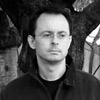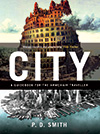There are two new beginnings in my life.
The first flower has opened in our new garden.

We recently left the Big Smoke (London) in search of time, space, and a garden. Maybe this camellia augurs well. Maybe we too can put down roots here...
And the second beginning?
Well, this blog, of course. (Thanks for inviting me, Brad!)
Anyone who has followed my blog on MySpace will have noticed I'm a lazy blogger.
But life has been pretty hectic recently, what with moving house and living with builders, plumbers, plasterers, and electricians. That lot can be noisy house-mates.
That's my excuse anyway. I'll try to turn over a new leaf. Promise.
What will the blog be about?
Well, my new book Doomsday Men traces the origins of the dream of the superweapon in science and popular culture. It's a reminder of how close we came to wiping out life on earth in the cold war.
This haunting image is of the first atomic explosion, the Trinity test, in the New Mexico desert on July 16, 1945. It was "the nearest thing to doomsday that one could possibly imagine", said one eye-witness.

Just before it exploded, physicist Enrico Fermi was taking bets on whether it would set fire to the atmosphere and destroy the world. He had some sense of humour.
But I don't want to just bang on about the Bomb.
Perhaps I'll keep that for my own site, which hopefully will be up and running in a few weeks.
I'd like to range a bit wider here.
As I do a lot of reviewing, and publishers are always sending me their latest offerings, there will certainly be highlights from new books in popular science and cultural history. And if any have caught your eye, then do let me know.
Beyond that, I hope to share some ideas I'm currently exploring in my own writing. It helps to talk about these things.
Want to join in?
Here's a great quote to whet your appetites:
"the precision of the artist should accompany the passion of the scientist."
(I'm tempted to add "Discuss". But I won't.)
It's from Nabokov, natürlich.
As well as writing some of the greatest novels of the twentieth century, he was a scientist working at the cutting edge of lepidoptery. In the 1940s he spent 14 hours a day glued to his microscope at the Harvard Museum of Comparative Zoology. He was dissecting the genitalia of the South and North American polyommatine butterflies known as the "Blues".
Well, I suppose someone had to do it.
By the way, the Nabokov quote is from James Hamilton-Paterson's beautifully written book on the science and history of the ocean, Seven Tenths.
I've just been reading it for review. It was originally published in 1992 and now Faber have reissued it.
As a writer who is also fascinated by the links between science and literature, what Hamilton-Paterson does with words makes me green with envy. If you want a masterclass on prose writing, and particularly on how to combine science and literature, then read this book. It's superb.
But now it's time to go.
I have to dig a hole in the garden. A big hole.
There's a six-foot bamboo plant just itching to gets its feet out of a pot and into the earth.
[originally posted on The Nervous Breakdown]












